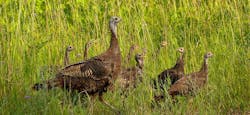The millions of miles of utility rights-of-way (ROW) transecting the country equate to a sizable footprint on the nation’s landscape. While delivering reliable power is the chief objective, these expansive spaces also offer a unique opportunity to advance biodiversity through habitat conservation for wildlife and pollinators when the proper management methods are used.
As a leader in wildlife conservation, the National Wild Turkey Federation (NWTF) recognizes this potential. It’s why the organization has developed what it calls the Energy for Wildlife Rights of Way Habitat Endorsement Program. Through the program, NWTF works alongside energy partners, surface landowners and a variety of stakeholders to promote the installation and maintenance of diverse habitat and methods to maintain it in an environmentally conscious way.
“We recognize the tremendous habitat enhancement potential of the nation’s energy rights-of-way and how the proper long-term maintenance methods can help capitalize on that opportunity, while also helping utilities realize cost benefits and ensure safe and reliable energy delivery,” said Steve Barlow, director of energy partnerships with the National Wild Turkey Federation. “The purpose behind the program is to encourage the development and maintenance of diverse early successional habitat using Integrated Vegetation Management practices.”
How it works
Energy companies that wish to participate can enroll their rights-of-way where IVM is practiced to the Integrated Habitat Management (IHM) level. IHM is an elevated approach to vegetation management that encourages practices such as selective herbicide applications to help maintain compatible plant species deemed favorable for wildlife, individual plant treatment (IPT) applications, prescribed fire and reseeding of native flora and even practices such as forming brush piles from trimmed limbs instead of chipping or removing them.
There are then annual participation levels where partners designate miles of ROW (from 40 to 2,500) as part of the program. Partners then receive additional benefits based on the level of sponsorship selected, such as co-marketing opportunities with the NWTF that promote program involvement — giving utilities the opportunity to showcase their commitment to stakeholders and the general public.
To qualify for the program, enrolled ROWs must be managed to promote and maintain early successional habitat. Criteria include:
- ROWs are maintained under a written IVM plan that includes detailed management practices and a practice schedule.
- Vegetation management practices adhere to the NWTF Habitat Endorsement approved practices matrix.
- IVM program adheres to American National Standards Institute (ANSI) standards.
- All management practices are following the regulations set forth by regulatory agencies and industry standards, and surface owner/local needs.
- Mechanical control is approved only in instances of new ROW development, side-trimming, emergency clearing or where required to meet federal or local requirements. Areas with routine mechanical control regimens on the ground are typically not approved.
Meeting these criteria and participating in the program demonstrates a utility’s strong commitment to conservation practices and established industry best management practices. That, along with having the third-party endorsement of a leading conservation organization, can be beneficial in enhancing landowner relations.
Partnering with an industry leader
As a long-time supporter and leader in the development of IVM practices in vegetation management, Corteva Agriscience has signed on as a key program partner of the Energy for Wildlife Program.
“Corteva Agriscience is honored and excited to partner on such a groundbreaking initiative,” said Damon Palmer, U.S. Pasture and Land Management leader at Corteva Agriscience. “As an advocate for an integrated vegetation management approach, the NWTF understands the importance of a formalized program to help companies achieve enhanced habitat using the proper maintenance practices.”
To help utilities meet the program’s criteria, Corteva Agriscience offers a robust portfolio of selective herbicides such as TerraVue™, Milestone® and Vastlan® herbicides, which vegetation managers can use to control invasive plants and woody species with little-to-no damage to surrounding desirable vegetation especially when applied in a selective manner.
As part of the partnership, Travis Rogers, market development specialist for Corteva Agriscience, was a presenter at the recent NWTF Annual Convention and Energy for Wildlife Session in Nashville, Tennessee. He spoke about the role Corteva is playing in the program as a key sponsor, as well as how herbicides are a critical component of IVM to both control invasive and undesirable species, while increasing wildlife habitat.
For vegetation managers interested in learning more about the Energy for Wildlife Rights of Way Habitat Endorsement Program, please visit https://www.nwtf.org/about/energy-for-wildlife.
Label precautions apply to forage treated with Milestone or TerraVue and to manure and urine from animals that have consumed treated forage. Consult the label for full details.
™ ® Trademarks of Dow AgroSciences, DuPont or Pioneer, and their affiliated companies or their respective owners. When treating areas in and around roadside or utility rights-of-way that are or will be grazed, hayed or planted to forage, important label precautions apply regarding harvesting hay from treated sites, using manure from animals grazing on treated areas or rotating the treated area to sensitive crops. See the product label for details. Milestone, and TerraVue are not registered for sale or use in all states. Contact your state pesticide regulatory agency to determine if a product is registered for sale or use in your state. State restrictions on the sale and use of Vastlan apply. Consult the label before purchase or use for full details. Always read and follow label directions.
Sponsored by:
